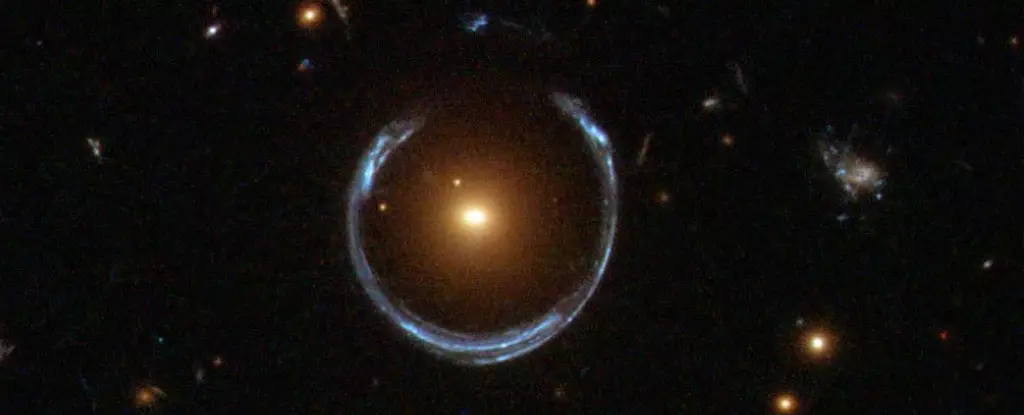In 2007, a remarkable astronomical phenomenon was unveiled—a gravitationally lensed system of galaxies known as the Cosmic Horseshoe, located approximately five-and-a-half billion light-years away. This phenomenon occurs when the mass of a foreground galaxy acts as a natural lens, bending and amplifying the light from a more distant background galaxy. The result of this perfect alignment is the creation of an Einstein Ring, a stunning visual effect predicted by Albert Einstein’s theory of General Relativity. The Cosmic Horseshoe has since served as a compelling subject for astronomers, revealing intricate details about the relationship between mass, light, and the fabric of spacetime.
Recent research has positioned this extraordinary system in the spotlight yet again, bringing forth the discovery of an Ultra-Massive Black Hole (UMBH) situated at the core of the foreground galaxy. This UMBH boasts a staggering mass of 36 billion solar masses, significantly exceeding the typical thresholds observed for supermassive black holes (SMBHs), which often range from millions to several billion solar masses. Although a standardized definition of UMBHs remains elusive, their existence has become crucial in enriching our understanding of galaxy structure and evolution.
The groundbreaking paper titled “Unveiling a 36 Billion Solar Mass Black Hole at the Centre of the Cosmic Horseshoe Gravitational Lens,” led by Carlos Melo-Carneiro from the Instituto de Física, Universidade Federal do Rio Grande do Sul in Brazil, brings new insights into the dynamics of the Cosmic Horseshoe. This discovery highlights the ongoing debate surrounding the formation and growth of black holes, particularly those that defy conventional understanding.
The journey toward comprehending supermassive black holes has roots that stretch back over a century. The late 19th and early 20th centuries marked a pivotal evolution in the understanding of physics, wherein the ideas of relativity began to reshape prior beliefs established by Newtonian mechanics. The intersections of space and time, along with the concept that massive objects could warp spacetime, laid a foundational framework for black hole theory. Notably, while Einstein’s predictions regarding gravitational lensing were made in 1936, they went uncorroborated during his lifetime. Today, however, astronomers can marvel at countless manifestations of gravitational lenses across the cosmos.
Among the most notable foreground galaxies is LRG 3-757, identified as a Luminous Red Galaxy (LRG). LRGs are characterized by their brightness in the infrared spectrum and are significantly more massive than the Milky Way—LRG 3-757 is around 100 times the mass of our home galaxy. The immense mass of this galaxy has made it a focal point for studying the connection between black holes and their host galaxies.
The Mass-Velocity Correlation
A critical aspect of the research focuses on the MBH-sigmae Relation, which examines the correlation between the mass of an SMBH and the velocity dispersion of stars within the galactic bulge. Higher velocity dispersions indicate more significant variations in the speeds of stars, creating a deeper understanding of galactic dynamics. Notably, a tight correlation between an SMBH’s mass and galaxy velocity dispersion enables astronomers to infer black hole masses based on observed stellar movements. However, the discovery of LRG 3-757 challenges this convention, as its UMBH exceeds expectations set by the MBH-sigmae relation.
The findings point toward an emerging trend where several UMBHs diverge from the standard correlations identified in other galaxies. This shift poses intriguing questions regarding their formation, suggesting a potential alteration in the evolutionary pathways of these massive galaxies.
Several hypotheses may illuminate the underlying reasons for LRG 3-757’s anomalously high black hole mass in relation to its velocity dispersion. One consideration is that the galaxy could represent a “fossil group,” characterized by large central galaxies that emerged from numerous mergers. This notion suggests a distinct evolutionary trajectory compared to more commonly observed galaxies today. The scouring effect, which occurs during the merger of two massive galaxies, could also have influenced the stellar dynamics within LRG 3-757, potentially lowering its velocity dispersion while keeping the black hole’s mass relatively stable.
Another contributing factor could be the feedback mechanisms from an Active Galactic Nucleus (AGN). As a black hole actively accretes matter, it can foster powerful jets and outflows that may inhibit star formation, leading to altered dynamics and structural properties of the galaxy.
Continued observation and research are crucial for unpacking the mysteries surrounding LRG 3-757 and similar cosmic structures. Future endeavors, particularly the Euclid mission, promise to deepen our understanding, with expectations of identifying numerous gravitational lenses over the coming years. Furthermore, advancements in observational technology, such as the Extremely Large Telescope (ELT), will allow for more granular studies of velocity dispersion and galaxy dynamics.
As we continue to explore the cosmos and unravel the complex interplay between massive black holes and their galactic hosts, each discovery brings us closer to understanding the formation and evolution of galaxies throughout the universe. The Cosmic Horseshoe stands as a testament to this endeavor, challenging our knowledge while igniting curiosity about the hidden narratives locked within the depths of space.

